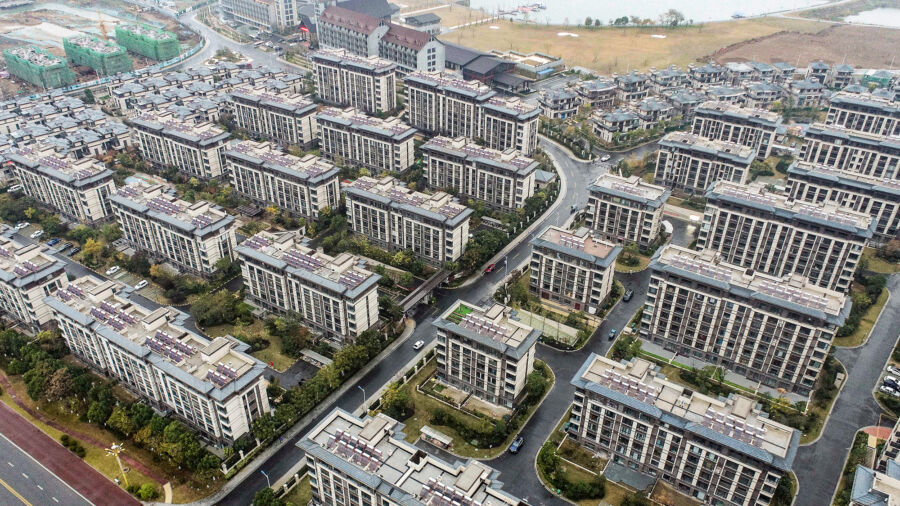News Analysis
Many foreign investors are concerned and asking questions about how China’s slowing economic growth, real estate crisis, and other economic problems could impact their businesses and interests.
China, the world’s second-largest economy and a major engine of global growth, is facing enormous economic challenges, prompting fears about its stability and future. Although Beijing claims that the economy has returned to its pre-pandemic trend level, a deepening real estate crisis, external headwinds like trade tensions with the United States, massive debt burden, and global inflationary pressures have reduced China’s export competitiveness and are threatening to send the economy into a long-term slump.
Post-Pandemic Economic Revival Stalled
Why has China’s economic post-pandemic revival stalled? Is it more cyclical than structural?
According to a restricted-circulation client note obtained by The Epoch Times from UBS Securities Asia, China’s economy was expected to recover this year after nearly three years of zero-COVID policy, with consumption recovering due to economic normalization and the release of household savings.
After a sharp dip last year, experts believed property activity would stabilize, and Beijing’s small budgetary spending growth would offset export declines.
But UBS noted that house starts and sales declined dramatically in the second quarter (Q2) and third quarter (Q3) in 2023, ending the brief property bounce back. The absence of policy easing for homebuyers and developer aid and a deteriorating market sentiment also triggered a fresh drop in property activity.
Lower global demand was hurting exports during Q2, and reduced land sales and lower-than-expected fiscal receipts lowered general fiscal spending, which reduced the fiscal expenditure by 1 percent of GDP in the first quarter (Q1) this year.
Since families did not spend their money, consumer confidence remained low.
Thus, some economists and analysts believe China’s economic problems are structural due to a declining population, tougher restrictions that damage private sector confidence, and foreign decoupling pressures.
Ms. Wang believes the economic problems are cyclical.
“However, notwithstanding demographic challenges in the long term, China’s current weak labor market and high youth unemployment suggest cyclical problems and that the economy is running below potential growth,” noted UBS economist Tao Wang.
She added that policy tightening, the pandemic, and lockdowns caused the steepest property reductions in history, which reflected shifting long-term fundamentals, including demographics.
Business confidence is low due to regulatory tightening, lingering concerns about the private sector’s future, pressures to shift supply chains away from China, and falling orders and earnings due to weak domestic and global demand, partly due to saturated demand for Chinese technology products.
“We believe cyclical factors are equally responsible [for] the economic slowdown,” she wrote.
Lack of Stimulus
Why has Beijing not given out more stimulus so far?
Foreign investors wonder why policy measures have been less robust after the July Politburo meeting and if Beijing still cares about economic development.
According to UBS, growth is still a government aim, not the sole or dominating one.
“One reason for the slow policy move might be a delayed comprehension of the weakness in China’s recovery: The recovery has been uneven, with strong parts [including domestic travel and, in Q1, property] coexisting with areas of weakness,” wrote Ms. Wang.
She also noted that the current economic issues are complicated, and budgetary headroom is limited, so there is no straightforward stimulus to boost the economy.
“The property sector certainly needs support and developers badly need additional credit, but it is unclear to the government whether they should and could reflate the property market given falling population, slowing urbanization, high home ownership, and high leverage,” she wrote.
However, according to Adam Upton, portfolio manager for Asian Equities with Hong Kong-headquartered AOP Capital, a large-scale stimulus focused on the property sector might be effective at reviving short-term activity, but it does “nothing to rebalance economic growth away from fixed asset investment and would cause bigger problems” in the future.
“While there are many forms of stimulus that could provide an instant boost, the Chinese government has so far demonstrated it is prepared to live with lower growth in order to rebalance the economy,” Mr. Upton told The Epoch Times.
“Structural adjustments such as Hukou and tax reform, while less exciting for markets in the short term, are more important for long-term sustainability,” he added. “Hukou” refers to China’s household registration system.

Real Estate Crisis
What is the most likely path of the property sector downturn? What is Beijing’s role?
“The two comparisons most often cited when looking at China’s real estate sector problems are Japan in 1990 or Hong Kong in 1997,” said Mr. Upton.
According to him, while every situation is different in terms of income, affordability, and inventory levels, Japan’s property market, from peak to trough, was roughly 14 years, while Hong Kong’s was around six years.
“Using those experiences as a guide, it [the property downturn] could be at least another four to five years before the market finds its trough,” Mr. Upton said. “Further, when the dust settles in the sector, analysts broadly expect activity levels in the sector to be 20 to 30 percent below peak activity.”
This has implications for GDP growth “because something else [such as net exports, consumption, or government spending] is required to fill the space,” he added.
According to UBS, however, Beijing can support both the demand and supply side of the property market to help stabilize the sector. On the supply side, the central authorities could increase credit support to developers, including more policy bank lending to stalled property projects to ensure delivery and bridge financing to avoid large-scale defaults.
On the demand side, Beijing could remove remaining home purchase restrictions and lower down payment requirements for second mortgages to 30 percent (from 40 to 50 percent) in large cities.
On Aug. 31, China’s authorities, which include the housing ministry and the People’s Bank of China, proposed reform measures, such as removing home-purchasing restrictions in noncore districts of major cities such as Beijing, Shanghai, and Shenzhen. These restrictions—which limit property purchases by so-called unqualified nonresidents and the number of properties people can buy—have been in effect in numerous cities since 2010. Many smaller towns have relaxed home-purchase restrictions in recent years to promote demand, but big cities, which have traditionally been targets for speculative purchasing, have remained cautious.
Increasing investment in so-called “urban village renovation” and public housing construction could also help, according to Ms. Wang.
Debt Crisis
How severe is the debt crisis for Chinese municipalities? Is there going to be a major default? How might local debt problems be addressed?
The UBS note stated that China’s explicit local government debt, comprising regular and special local government bonds, was 35 trillion yuan (about $4.79 trillion), or 29 percent of GDP, by the end of 2022.
Debt of local government financing vehicles (LGFVs), on the other hand, was estimated to be roughly 59 trillion yuan as of 2022. Still, while not all LGFV debt should be counted as implicit local government debt, as some LGFVs were supposed to be commercially operated, various definitions would still put total local government explicit and implicit debt at 96 trillion yuan as of 2022 or 79 percent of GDP.
“Despite the severe challenge in debt payments, however, China is unlikely to see large-scale defaults of LGFVs going forward,” wrote Ms. Wang.
Local governments will be pressed to sell or optimally employ their assets to service and minimize implicit debt.
“Local governments own a lot of assets, including state-owned enterprises totaling yuan 206 trillion in 2021, and theoretically, local governments can transfer some of the assets to LGFV, sell them, or mortgage these assets for liquidity,” Ms. Wang wrote.
However, since state assets may not be easy to dispose of, as they may be hard to value and unfeasible to sell—for example, infrastructure—this process is likely to be only gradual, she added.
From The Epoch Times


